Written and photographed by Yvette Cardozo and Bill Hirsch
Vol. 10 No. 1
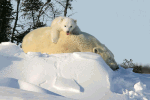 Photographing polar bears in Manitoba’s 4,300 square mile Wapusk National Park (Cree for “great white bear”) or the nearby larger Cape Churchill Wildlife Management Area is literally bone chilling. Tundra, that flat plateau dotted with bonsai-stunted spruce trees and wind rippled snow and ice evokes a unique beauty, one similar to that found in southwestern deserts. But we didn’t come to this desolate area in the frigid winter for its landscape; we came as photographers. Wapusk is home to one of the world’s largest polar bear denning populations.
Photographing polar bears in Manitoba’s 4,300 square mile Wapusk National Park (Cree for “great white bear”) or the nearby larger Cape Churchill Wildlife Management Area is literally bone chilling. Tundra, that flat plateau dotted with bonsai-stunted spruce trees and wind rippled snow and ice evokes a unique beauty, one similar to that found in southwestern deserts. But we didn’t come to this desolate area in the frigid winter for its landscape; we came as photographers. Wapusk is home to one of the world’s largest polar bear denning populations.
And also lovely. The flat tundra, with its bonsai-stunted spruce trees and wind rippled snow, evokes a kind the kind of unique beauty found in southwestern deserts. But we didn’t come to this desolate area in the frigid winter for its landscape; we came as photographers. Wapusk is home to one of the world’s largest polar bear denning populations.
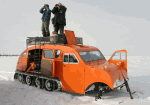 Ah, those cuddly-looking white bears. Ferocious as they may be, they still look adorable. They were worth every heart and camera clicking moment that we stood motionless like icicles. And I am talking about standing in one spot for four hours in North Pole-like temperatures.
Ah, those cuddly-looking white bears. Ferocious as they may be, they still look adorable. They were worth every heart and camera clicking moment that we stood motionless like icicles. And I am talking about standing in one spot for four hours in North Pole-like temperatures.
Those bears teased us by escaping our viewfinders the first three days. A shivering day wasn’t a total waste. During a blizzard, we saw 34 caribou, their noses raking the snow to search for dried moss. Minimal visibility made them look like brown ghosts. Another day we spotted bears deep in a willow thicket, but damn, too distant to photograph.
The skies remained gray with flat visibility until our fourth day. We couldn’t see a footprint a yard away. Still, each day the lodge guide, Morris, headed out to the tundra in search of bear tracks. With only 200 dens scattered along 150 miles of tundra, you can begin to appreciate the effort of tracking them.
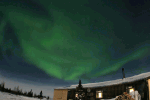 If a bear is sighted, policy requires photographers to remain a distance of 100 yards. This is not only for protection from a bear attack (frankly, the moms are totally focused on their cubs), but, more importantly, to ensure that the photographers don’t spook the bears.
If a bear is sighted, policy requires photographers to remain a distance of 100 yards. This is not only for protection from a bear attack (frankly, the moms are totally focused on their cubs), but, more importantly, to ensure that the photographers don’t spook the bears.
Against the odds, Morris found polar bears. Chugging south in our Bombardier vehicle, we carefully maneuvered our way across a snow filled creek and there, on a crest surrounded by a small stand of trees, was our first photo op: a mom with a single cub.
Serendipitously, a weak sun peaked through the clouds. For almost three hours, we snapped picture after picture. Focus, shoot! 100 frames of a cub nibbling at mom’s foot, leg, and ear. Then he moved toward her cheek, mouthing a tuft of hair. Click! Click! At this point, mom’s patience ran out. A quick huge paw caught the cub by the shoulder and firmly shoved him to her stomach. There, he greedily went back to nursing, nose down, rump up, hind paws scrabbling madly. Eventually, the cub came up for air and the two of them rolled, a tumble of paws, before collapsing for a nap. This was photog heaven.
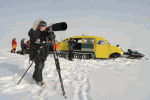 Polar bear females arrive in Wapusk during late summer to den. They hibernate during fall before birthing around December. When they emerge from their dens in mid February, the cubs are the size of large house cats. Mom, meanwhile, is starving. She hasn’t eaten for six months, and even with a lowered metabolism brought on by the frigid winter, she has lost a sixth of her body weight. She leads her cubs on short walks so they can build strength. In mid March, they’ll head for Hudson Bay’s pack ice where they gorge on their primary diet, seals.
Polar bear females arrive in Wapusk during late summer to den. They hibernate during fall before birthing around December. When they emerge from their dens in mid February, the cubs are the size of large house cats. Mom, meanwhile, is starving. She hasn’t eaten for six months, and even with a lowered metabolism brought on by the frigid winter, she has lost a sixth of her body weight. She leads her cubs on short walks so they can build strength. In mid March, they’ll head for Hudson Bay’s pack ice where they gorge on their primary diet, seals.
Photographers need to arrive prepared. The regulars on our trip toted 600 millimeter lenses, some brought teleconverters that added another 240 mm. The multiplication factor of digital cameras provided some photographers the ability to shoot almost 1,300 mm. All had sturdy tripods and tiny camp chairs, which provided an opportunity to get their feet out of the snow.
 In spite of the frigid conditions, there wasn’t much we could do about our freezing hands. Operating a camera with mittens is almost impossible. Most photographers wore thin gloves, lining their palms with hand warmers. When fingers go numb, you retract them from the gloves and grasp the hand warmers in hopes you might eventually regain some feeling. That’s before the bears start “posing” again.
In spite of the frigid conditions, there wasn’t much we could do about our freezing hands. Operating a camera with mittens is almost impossible. Most photographers wore thin gloves, lining their palms with hand warmers. When fingers go numb, you retract them from the gloves and grasp the hand warmers in hopes you might eventually regain some feeling. That’s before the bears start “posing” again.
After our golden moments with the mom and cub …we saw nothing for days. The weather was bad, the visibility worse. Yawn. We hung out at the lodge, reading, sleeping, watching movies. A week passed and it was time to go. And so typical of any trip, the weather report promised sun the day of our departure. So we did what most people do here, we extended our trip for two more days. Hey, it’s not easy to get to the boondocks of Manitoba. It’s worth a few airline penalties to get those perfect shots. Sure enough, our final day was sunny, though it was also 34 below with enough wind chill to freeze flesh in minutes. Bless Morris, he found more bears for us.
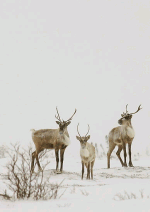 As we pulled up, the wind magically died. These new bears were perched on a snow bank in front of photogenic trees and, thankfully, facing the sun.
As we pulled up, the wind magically died. These new bears were perched on a snow bank in front of photogenic trees and, thankfully, facing the sun.
This time a cub chewed his mom’s foot and ears and face and whatever else he could reach. Then, mom went for a short stroll, circled the hill then scrambled up a small bank. The cub took a full five minutes to navigate the climb … scrabbling up, falling back, squealing for mom at the top of his tiny lungs. She gently grabbed his head with her teeth, more nudging than pulling. Finally, he clawed his way up … all to the sound of continuous clicks of a dozen camera shutters. Even the big time photography from National Geographic was impressed. “That,” he said after putting 10 rolls of film through his camera, “was special.”
Visiting Manitoba in the winter is challenging. Sighting polar bears is not a guarantee. But it’s the only place on Earth you can reliably and safely see polar bear moms with newborn cubs.
 The area has been a jealously guarded secret for pro wildlife photographers for years. Serious wildlife photographers come here yearly, it’s almost a religious pilgrimage. We were with some big time photographers including one with half a dozen National Geographic spreads to his name (he’d rather not have the world know Wapusk is where he snags his never-seen-anyplace-else shots). There were two videographers from Japan filming a documentary, a renowned sports photographer working on a wildlife book, a doctor who publishes calendars, and an Irish lad who specializes in photographing tigers.
The area has been a jealously guarded secret for pro wildlife photographers for years. Serious wildlife photographers come here yearly, it’s almost a religious pilgrimage. We were with some big time photographers including one with half a dozen National Geographic spreads to his name (he’d rather not have the world know Wapusk is where he snags his never-seen-anyplace-else shots). There were two videographers from Japan filming a documentary, a renowned sports photographer working on a wildlife book, a doctor who publishes calendars, and an Irish lad who specializes in photographing tigers.
“No matter how many bears we come across,” owner Mike Spence said later, “each one is different, each is amazing. When we find them, we know we’ve done our job. We smile and sit back and listen for the click, click, click of cameras.”
Wat’chee Lodge
Now, a bit about our digs: Wat’chee Lodge is in the middle of nowhere-northern-Manitoba. The building was originally a Navy communications base that went unused for decades. When Mike acquired the place 10 years ago it had no windows, rotting floors, marginal walls and a questionable roof. Since then, he has taken care of the important, survival stuff.
Lately, he’s also had time for a few luxuries. There’s a separate washroom for ladies and the toilets are topped with hand sculpted Styrofoam seats. There are rugs on the floor. Also a DVD player and satellite TV. No, there is NOT an internet connection. But Mike does own a satellite phone and a radio system that can patch you through to civilization in a hurry if needed.
The experience here is nothing like what you find in Churchill during fall (see Past Newsletters January, 2001 Lords of the Arctic: The Polar Bears of Churchill Manitoba. The months of February and early March are much colder, and the experience is less action packed. But, overall, its way, WAY more unique.
When we arrived in the city of Churchill, Lawreen Spence, Mike’s wife, greeted us at the airport for a quick ride to her office where she checked out our gear. Temperatures this time of year can hit minus -50 … without the wind chill factor. Proper clothing is an extremely serious subject. Looking at our ski wear she actually chuckled, and then she brought out two-inch thick insulated pants along with a coat that was easily three sizes too large with boots to match.” You will need extra room,” she said simply.
Flopping around her store, it hardly seemed possible but eventually, she was proven absolutely right. We stuffed four pairs of socks into our boots along with four or five layers of clothing under our coats.
Lawreen then took us to the train for a two hours plus journey. We arrived in Wapusk: desolate, the middle of totally, absolutely, nowhere. The temperature was -30F. But out of the darkness appear lights and two Bombardiers to transport us across the tundra.
These snow coaches became our warm security blanket. They’re part of that an old technology built during a time (1930s-1960s) when things were supposed to last. They looked like oversized Volkswagen Beetles that had accidentally mated with snowmobiles. They are noisy, bouncy and filled with gasoline fumes. But they are also the only multi passenger vehicles that can survive the conditions of the frigid tundra.
And as rugged as those things were, the slogging was more than worth it. Yes we got stiff. Yes we were beyond cold. But boy did we get world class pictures.
If you go:
If you go: Winter (mom-and-cub) season at Wat’chee Lodge runs mid February to mid March. Churchill is the airline gateway city followed by a 40 mile train ride to the lodge pickup point. The lodge sits on a low, long hill above the tundra. It has generator power stable enough to run a laptop but no running water.
Expect temperatures as low as minus 40 or more, not including the wind chill. Bring plenty of warm layers, warm socks, warm gloves plus a large supply of chemical hand and foot warmers. Plan to rent outer wear including arctic boots and heavy mitts. Wat’chee Lodge has a limited supply of clothing.
Wat’chee Lodge: go to www.watcheelodge.mb.ca or watchee@churchillmb.net
204.675.2114
